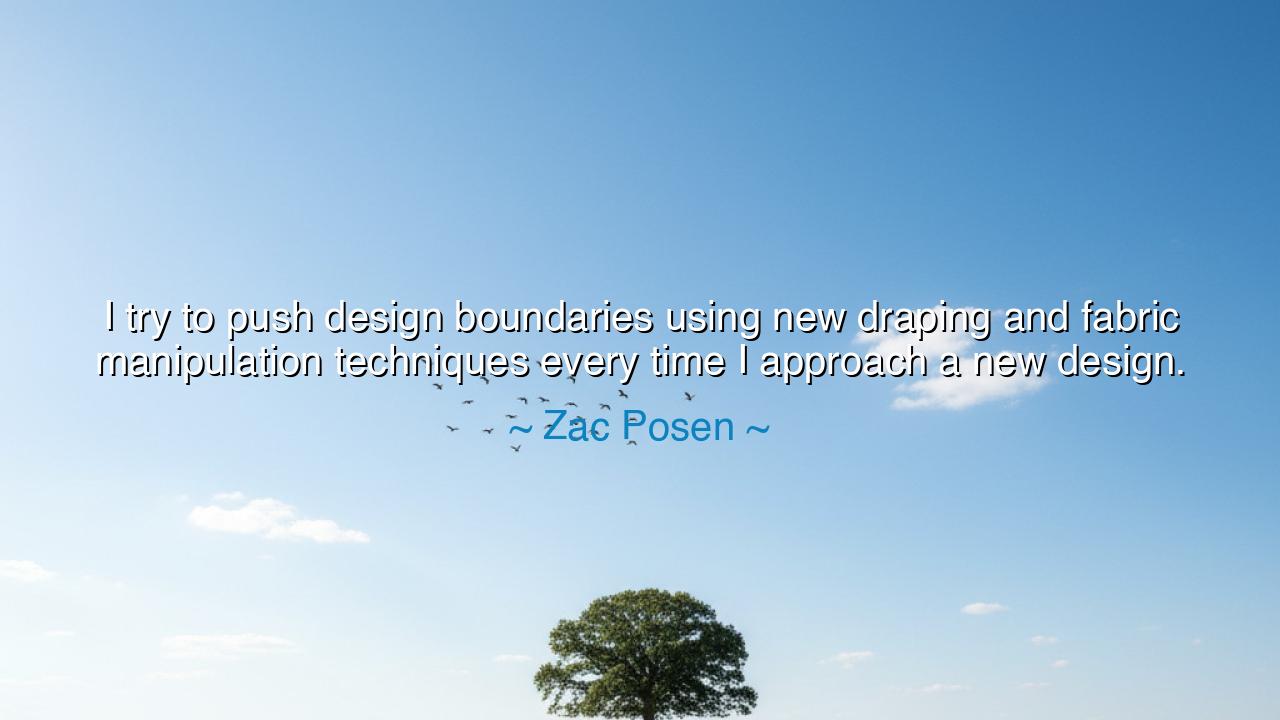
I try to push design boundaries using new draping and fabric
I try to push design boundaries using new draping and fabric manipulation techniques every time I approach a new design.






The fashion designer Zac Posen, celebrated for his daring craftsmanship and architectural elegance, once declared: “I try to push design boundaries using new draping and fabric manipulation techniques every time I approach a new design.” These words, though spoken in the language of fashion, carry the heartbeat of all creative pursuit—the eternal struggle between tradition and innovation, between what has been done and what has yet to be imagined. In this statement lies the essence of artistic courage: the refusal to be content with repetition, the relentless drive to expand the boundaries of beauty through experimentation and risk.
To push design boundaries is to stand at the edge of the known and look into the unknown. It is the act of one who dares to shape form out of uncertainty. For Posen, this means transforming fabric—the most ancient and humble of materials—into something alive, something that breathes emotion and structure all at once. His art is not merely to sew or adorn, but to sculpt movement, to coax the fabric into forms that defy gravity, expectation, and time. In every fold, in every daring cut, there is an echo of the divine impulse to create anew. He reminds us that mastery is not preservation, but transformation.
The origin of such a philosophy lies deep in the history of art and invention. The ancient Greeks, masters of proportion and drapery, understood that the human form could be elevated to the divine through the flow of cloth. Their statues, wrapped in marble folds that seemed to flutter like silk, captured both precision and fluidity. Centuries later, Leonardo da Vinci and Michelangelo sought the same union of art and science, bending technique to serve vision. Posen stands in this lineage of creators who see no boundary between the practical and the poetic. Like them, he knows that technique is not a cage—it is a key, and every new method of draping or manipulation unlocks another secret of beauty.
Yet, to innovate is not without peril. Every artist who ventures beyond the familiar risks failure, criticism, even ridicule. The world often clings to what it understands and resists what is new. The story of Coco Chanel serves as a beacon here. In an age when fashion was bound by corsets and formality, she dared to free the body, introducing comfort as elegance. Her simplicity was revolutionary, and she was mocked for it—until the world finally realized that she had redrawn the map of femininity. Like Chanel, Zac Posen’s quest for new draping and manipulation is not indulgence; it is rebellion in service of refinement.
The emotional heart of Posen’s quote lies in his devotion to process. He does not speak of fame, nor of success, but of approach. “Every time I approach a new design,” he says, for creation is a journey repeated again and again—each time a rediscovery of possibility. This is the sacred rhythm of the artist’s life: to return to the work with wonder, to forget mastery long enough to find mystery. The wise creator knows that the moment he stops experimenting, he stops growing. The fire of creativity must be fed not with comfort, but with curiosity and risk.
This truth extends far beyond fashion. Every craft—whether painting, writing, architecture, or leadership—demands this courage to reimagine the familiar. The scientist who discovers new medicines, the teacher who rethinks how to inspire, the musician who reinvents melody—all are engaged in the same divine act that Posen describes: the manipulation of the known to birth the unknown. Progress, whether artistic or human, depends on those who dare to shape the fabric of existence differently each time they touch it.
Thus, the lesson is clear: do not approach creation as repetition, but as revelation. Whether you craft garments or build dreams, strive always to push the boundary of your medium. Do not fear failure, for every fold that falls imperfectly brings you closer to the drape that will one day move the world. Like Zac Posen, make experimentation your faith and evolution your art. The tools may change—needle, pen, chisel, or code—but the calling remains the same: to transform raw material into meaning, and to never cease refining the hands and heart that shape it.
And so, remember this teaching: each new creation is an act of courage, and each boundary you cross is an offering to the eternal muse of innovation. When you approach your work—whether it is of fabric, thought, or spirit—do not settle for what has been done. Instead, drape your imagination around the unseen, manipulate the material of your craft until it sings, and let the world, in awe and gratitude, see that beauty is not found in comfort, but in boldness reborn with every new design.






AAdministratorAdministrator
Welcome, honored guests. Please leave a comment, we will respond soon